Markets Brace as Trump’s Second Year Spurs Global Unease
One year after President Donald Trump’s return to the White House, global equities have risen but diverged markedly, with Japan and China outpacing U.S. stocks. Investors are watching for a historically fraught second year of the presidential cycle, when policy uncertainty and the approach of midterm elections can lift volatility and trim returns.
AI Journalist: James Thompson
International correspondent tracking global affairs, diplomatic developments, and cross-cultural policy impacts.
View Journalist's Editorial Perspective
"You are James Thompson, an international AI journalist with deep expertise in global affairs. Your reporting emphasizes cultural context, diplomatic nuance, and international implications. Focus on: geopolitical analysis, cultural sensitivity, international law, and global interconnections. Write with international perspective and cultural awareness."
Listen to Article
Click play to generate audio
It has been a year since President Donald Trump’s second election victory, and while equity markets have broadly advanced, performance has been uneven across regions. The S&P 500 has climbed roughly 13% over the past year, but that gain trails Japan’s NI225, which is up about 27%, and China 3399300, which has risen roughly 16%. The pattern underscores shifting global dynamics as investors position for policy developments and the midterm calendar.
The divergence highlights how market fortunes are increasingly shaped by local dynamics as well as global capital flows. Asian equity strength has outpaced the U.S., drawing fresh interest from international investors seeking higher returns and diversification. The relative outperformance of Japan’s index reflects factors beyond the headline numbers, including sector composition and the influence of exporters and technology-related names, while gains in China have been interpreted as a sign of regained investor confidence in select domestic sectors.
At the same time, some strategists caution that the gains come against a backdrop of political uncertainty at home. According to Barclays, historical precedent suggests caution: "Looking at data since 1927, it is pertinent to note that US equities typically struggled the most during the second year of the Presidential term, in the run up to the mid-terms," write Barclays equity strategists. That observation captures a long-run relationship between the U.S. election cycle and market volatility, as policy battles and legislative stakes intensify ahead of congressional contests.
For global investors, the second-year phenomenon means reassessing risk-management strategies. Equity allocations that outperformed in the immediate post-election rally may face pressure if volatility rises or if expectations about fiscal policy, regulation, and geopolitical engagement change. Currency moves and regional central bank posture could amplify these trends, influencing cross-border capital flows and valuations.
The coming months will test whether the market environment that produced solid returns in the first year can persist. Corporate earnings, interest-rate trajectories and the unfolding political calendar will be closely watched. For multinational companies and exporters, the interplay of trade dynamics and domestic policy choices in Washington and in Asian capitals will be a critical determinant of revenue prospects and investor sentiment.
Beyond raw returns, the first-year divergence has geopolitical implications. Stronger Asian markets carry messages about local economic resilience and policy management, while relative U.S. underperformance raises questions about investor confidence in the domestic outlook. As midterms approach, both political maneuvering in Washington and the global reaction will shape not just market performance but the broader international economic picture.
Investors who remember the historical pattern highlighted by Barclays are likely to enter the second year with guarded positions, balancing the search for yield against a calendar that has often proved unfavorable for U.S. equities in years past. © Copyright Thomson Reuters 2025.


